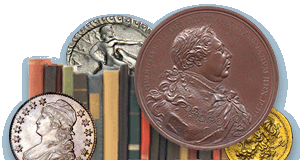
PREV ARTICLE
NEXT ARTICLE
FULL ISSUE
PREV FULL ISSUE
BOLIVIAN MONEY MUSEUMIn conjunction with Bolivia's bicentennial, Bolivian collector Víctor Borda and his family are displaying his collection of over 3,000 pieces covering over 8,000 years of monetary history in a hall in his hometown of Cochabamba. Found via News & Notes from the Society of Paper Money Collectors (Volume XI, Number 12, September 2, 2025). -Garrett To mark Bolivia's bicentennial, a family in Cochabamba has opened a door onto 8,000 years of value—stones, salt, coca leaves, silver reales, banknotes swollen by hyperinflation, even tokens for bitcoin. For collector Víctor Borda, money is no longer just an artifact. In his hands, it has become a memory Bolivians can touch. A childhood hobby becomes a bicentennial museum. Inside a bright hall in Cochabamba, coins gleam in ordered runs of copper and silver while banknotes fan out like pressed flowers. Together, they comprise the Borda-Luna collection, nearly 3,000 pieces that trace humanity's attempt to measure worth—from primitive exchange objects to digital-age medallions. Its architect, 74-year-old Borda, began the hunt with a child's curiosity. "I started collecting at age 10 or 11; it was a wholesome pastime, and here I am," he told EFE, smiling at how a boy's diversion turned into a lifelong pursuit. The obsession deepened between 2004 and 2009, when Borda lived in the United States and gained access to pieces so rare he once flirted with chasing a Guinness World Record. Family duty brought him home, but it also gave the collection its true purpose. Together with his wife, Sara Luna, he cataloged every piece—first by hand, then on a typewriter, later on a computer—so that, as he put it to EFE, "my people can see the world without paying a cent." In a country where most citizens may never travel beyond the Andes, the museum offers a passport stamped in silver, paper, and polymer. From stones and salt to silver and satoshis The exhibition's story begins far before the minting of coins. More than 8,000 years ago, nomadic communities traded what they could carry: polished stones, the glint of salt, the iron "kisi penny" from West Africa—shaped for strength and longevity. In the Andes, the twist was unmistakably local. "Even coca leaves served as primitive money—one handful was a day's wage in the Inca era," Borda explained to EFE. The next rooms unfurl into Bolivia's own deep monetary past. Colonial silver reales from the Casa de la Moneda in Potosí anchor the section: some precisely struck, others crude "cobs" hammered quickly to satisfy the world's insatiable appetite for silver. Nearby cases capture the tokens of daily life—telephone chips, casino markers, foosball slugs—small things that once opened doors, bought time, or granted a game. And then, with a wink, the present arrives. Borda has assembled physical commemoratives of virtual currencies: bitcoin medallions that cannot buy bread but allow visitors to imagine the intangible flows reshaping the financial world. Across the room, Bolivia's newest commemorative banknote, designed for the bicentennial, sparkles with security threads and patriotic pride. Faces, crises, and the power of paper Paper money carries not just value but people. And this museum insists on asking who is missing as much as who is present. "We must give women their space; the vast majority of coins and bills have featured men," Borda told EFE. A dedicated case honors women who did make it into circulation: Eva Perón, Colombia's anthropologist Virginia Gutiérrez, Britain's Jane Austen, and Peru's singer Chabuca Granda. Their portraits, displayed together, remind visitors that recognition in currency is recognition in history. Another display throbs with the adrenaline of collapse. Bolivia's own hyperinflation of the 1980s—soaring past 4,000%—fills a row with dizzying denominations bearing the images of Juana Azurduy and Eduardo Abaroa. But the lesson is global: notes from Zimbabwe and the former Yugoslavia trail strings of zeros that blur into absurdity. To hold such paper is to feel power evaporate between your fingers.
To read the complete article, see:
Wayne Homren, Editor The Numismatic Bibliomania Society is a non-profit organization promoting numismatic literature. See our web site at coinbooks.org. To submit items for publication in The E-Sylum, write to the Editor at this address: whomren@gmail.com To subscribe go to: Subscribe All Rights Reserved. NBS Home Page Contact the NBS webmaster 
|

